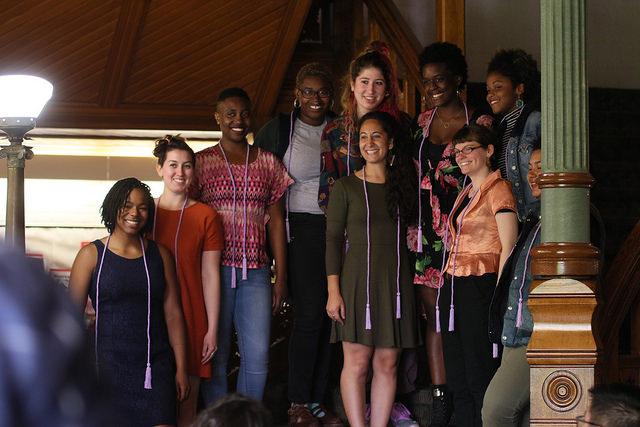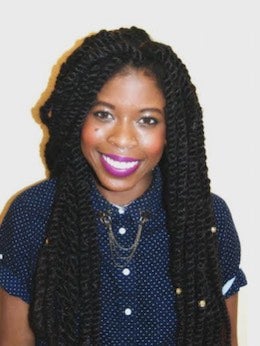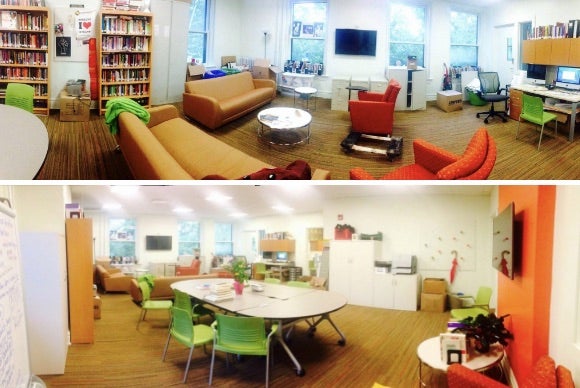Campus News
20 Years of the Multicultural Resource Center
June 9, 2016
Lisa Gulasy

Members of the Class of 2016 pose for a photo at the 2016 Oberlin Lambda Alumni and Multicultural Resource Center Colloquium & Lavender Celebration.
Photo credit: Amber Benford
The Multicultural Resource Center (MRC) is a such a crucial piece of the Oberlin experience for so many students that it can be difficult to believe it hasn’t been around since the college’s founding. And yet, the MRC turned just 20 in the 2015-2016 academic year.
As the MRC’s 20th anniversary year comes to a close, we celebrate its critical role on this campus by looking back on the causes for its establishment as well as sharing how it has evolved throughout the years.
Founding the MRC
The MRC was founded in 1995 early in the tenure of Oberlin College’s first female president, Nancy Schrom Dye. The founding of a cultural center was one of several recommendations posed by a university-wide task force charged with finding ways the college could better address the needs of students from marginalized backgrounds.

“Cultural centers are not unique to Oberlin and were created on predominantly white campuses, as historically underrepresented students were routinely excluded from higher education institutions throughout the 19th and early 20th centuries,” says Antoinette (Toni) Myers, interim assistant dean of students and director of the Multicultural Resource Center. “The importance of multicultural centers on liberal arts college campuses is due to the relatively small populations of students of color.”
The MRC was created to serve as a hub for the collaborative support of historically underrepresented and disenfranchised student communities; communities that had expressed concerns about a lack of voice, representation, and campus resources. Students of color, first-generation students, international students, students with disabilities, LGBTQ students, low-income students all fall under this umbrella.
For 10 years, the MRC operated on “soft money” as the college grappled with how institutionally central it would be, says David Kamitsuka, associate dean of the curriculum of the College of Arts and Sciences and associate professor of religion. Adrian Bautista, associate dean of campus life and director of residential education, who served as the Latinx community coordinator from 1996 to 1999, says all community coordinator positions were considered internships throughout this time. This meant community coordinators’ pay was low, they did not receive benefits, and they were unlikely to stay in their positions for more than a year or two.
Then in the 2003-2004 academic year, Kimberly Jackson Davidson, associate dean of students and ombudsperson beginning July 2016, released the results of an extensive study she conducted, “the outcome of which underscored the importance of choosing community coordinators who were headed toward professional commitment,” says Linda Gates, emeritus dean of students and associate dean of student academic services. It was at that time that, according to Kamitsuka, the college made a “real commitment” to the MRC.
The first step in that commitment was to reclassify the community coordinator positions as Administrative and Professional Staff (A&PS), which drastically increased salaries and made benefits available. The second step was to bring aboard Eric Estes, current vice president and dean of students, as director.
"Eric Estes's role as director made an enormous difference,” Gates says. “Eric searched for and hired community coordinators with outstanding credentials and a strong commitment to community support and to issues of social justice, he provided excellent supervision and encouraged professional development, and he brought speakers to campus who appealed to specific student communities and to the campus as a whole."
“All of a sudden the MRC office changed,” Kamitsuka says. “Everyone in that office was a highly skilled student life professional as well as a highly skilled multicultural experience professional.” It was during this time, Kamitsuka says, the MRC began to establish its position as a fundamental component of Oberlin student life.
The MRC Today and Beyond
Today, the MRC has a professional staff of six, including interim director Myers, four community coordinators (Africana, Asian and Pacific Islander, Latinx, and LGBTQ), and an administrative assistant. The MRC also receives assistance from a handful of student workers.
In addition to supporting underrepresented student communities, the MRC today also strives to advance social justice education and multicultural understanding among all campus communities. The office works toward this goal by sponsoring various programming such as Latinx Heritage Month (LHM) and hosting speakers and workshops, all of which align with curricular offerings and appeal to all students, not just those within the represented community.

“Everybody comes to Oberlin with a different background and set of experiences, but everybody wants to have a place where they feel at home—that enhances learning, that enhances the whole human experience,” Gates says. “What the MRC seeks to do is to find some context and history that people who have different backgrounds and experiences can discover here at Oberlin so they can feel at home.”
“The MRC is for the campus as a whole. All of our students need to be competent and skilled in negotiating difference and diversity, both on an interpersonal level and an academic level,” Kamitsuka says. “The MRC facilitates that broader conversation.”
As for the immediate future for the MRC, Myers’ plans are comprehensive. “We have been talking about re-establishing our faculty advisory board so that we can build a more robust connection between our academic and cocurricular programs,” she says. “I also would like to spend some time investing in a structured system of support within the MRC for first-generation, low-income students. I imagine working with campus partners and researching ways our community at large can receive increased funding for special programs, internships, and summer opportunities.
“Finally, I would love to partner with the Office of Disability Services, athletics, the Office of Religious and Spiritual Life, student academic services, and the counseling center, just to name a few. I think that it would be important to cosponsor more intersectional programs around disability, emotional and mental health, and spirituality in queer people of color communities this year.”
Twenty years from now, she says it is her greatest hope that “we no longer have to ask why multicultural/cultural centers are necessary,” particularly on liberal arts college campuses. “Oberlin does not exist in a vacuum,” she says. “Having a Multicultural Resource Center on campus will continue to be necessary as long as we live in a society that privileges the experiences, narratives, and perspectives of dominant populations.”
You may also like…
Statement Regarding Coronavirus
The college is closely monitoring developments in the outbreak of a new strain of coronavirus, known as 2019-nCoV.
Arriving in Fall 2020: New Tool to Enhance Students’ Academic Journey
In fall 2020, the college will launch new software that will be used to communicate and manage connectivity with students. The software platform, Engage, is a communication and relationship management tool that will improve the student experience with academic advising, support student academic success, and make communications between students and the college more efficient and effective.


